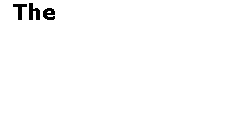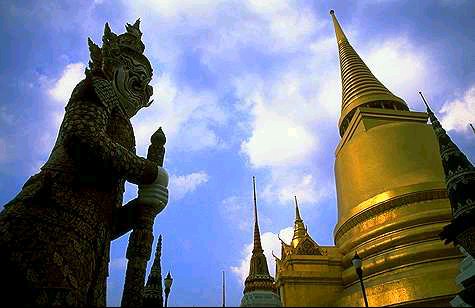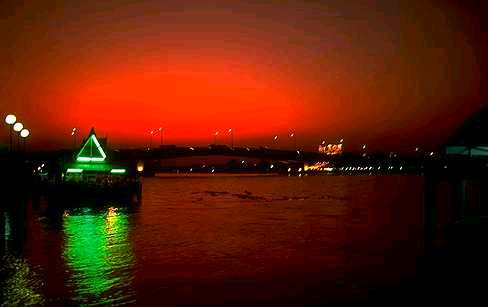
|
The intrepid voyages of James Luxford.
Bangkok, Mekong River, Ho Chi Minh Trail, Ho Chi Minh City, Phnom Penh, Angkor, Mandalay, Melaka

|
The intrepid voyages of James Luxford.
Bangkok, Thailand
Bangkok, the capital and chief port of Thailand, is located on the Chao
Phraya River, 40 km. (25 miles) upstream from its outlet into the Gulf of
Thailand. It has a population of approximately six-million. Rice, rubber,
tin, and timber are the chief exports. Originally a small port serving
Ayutthaya the former capital of Siam, Bangkok became capital in 1782
when the founder of the Chakri dynasty, King Rama I, built his palace
there. The city is rich in Thai culture and is a popular tourist
destination. Its principal modern industries include rice mills, oil
refineries, sawmills, shipyards, and textile factories. There is also a
famous trade in jewellery.


The Bangkok Sunset
Mekong River
Ho Chi Minh Trail
Ho Chi Minh City
Mekong, the major river of south-east Asia and the world's tenth longest at 4,200 km (2,600 miles). Rising in the Tanglha range of Tibet, it first tumbles through craggy gorges some 3,000 m (9,800 feet) above sea-level and then runs southward through south China into Laos. The Khone Falls in southern Laos are a series of rapids 10 km (6 miles) long, the widest in the world and a source of hydroelectricity. Below them the river enters its floodplain, which extends through Cambodia (Kampuchea). Here it becomes navigable and irrigates the land. During the dry season it receives the Tonle Sap River, whereas during the rains it reverses the flow, forcing floodwaters back into the Tonle Sap Lake. Its delta, over 320 km (200 miles) wide, thrusts into the South China Sea. The river here splits into many distributaries, providing soil and water for one of Asia's chief rice-growing areas.
The Ho Chi Minh Trail is a covert road system crossing the Truong Son Mts. on the western frontier of
Vietnam, built by the North Vietnamese during the 1960s to act as a supply line for ammunition, food,
and medicine en route from North Vietnam to revolutionary forces in South Vietnam, Cambodia, and Laos.
It comprised five main roads, 21 branches, and many detours with a total length of c.16,000 km.
(10,000 miles).
Ho Chi Minh City is a city in southern Vietnam, on the Saigon River; pop. (est. 1991) 3,450,000. Made
capital of the French colony of Cochin China in 1859, it was known as Saigon until 1975 when it was
named after the Vietnamese Communist statesman who led his country in its struggle for independence
from French rule. It is now the largest city and one of the chief industrial centres of Vietnam centred
on the adjacent town of Cholon. Industries include ship-building, textiles, machinery, pharmaceuticals,
and the manufacture of diverse consumer goods. The deep-water port on Kanh Ho Island handles almost
all the trade of southern Vietnam.

Phnom Penh
Angkor
Phnom Penh is the capital of Cambodia, and a port at the junction of the Mekong, Bassac, and Tonle Sap
rivers; pop. (est. 1994) 920,000. Founded by the Khmers in the 14th c., it succeeded Angkor as capital
in the mid-15th c. During the 1970s and 1980s its population fluctuated dramatically, first in response
to an influx of refugees after the spread of the Vietnam war to Cambodia, and second when the Khmer
Rouge took over the city in 1975 and forced its population of 2.5 million into the countryside as part
of a radical social programme. The city was repopulated after the arrival of the Vietnamese in 1979.
Angkor, in Cambodia, is the site of several capitals of the Khmer empire. It is renowned for the temples
which the Khmers built between the 9th and 12th centuries for their god-kings to live in after death.
At Angkor Thom was the grandiose Bayon (temple) of Jayavarman VII (1181-c.1220); on pinnacle after
pinnacle the king's features live on in the faces of the Buddha. Under this Buddhist king, Angkor Thom
reached its zenith. The city, with its 13 km. (8 miles) of moated walls and position on the shores of
the vast inland lake of Tonle Sap, lay at the heart of an elaborate irrigation system which was
partially laid out and controlled by the Khmer kings. For centuries the city and the great temples,
with their bas-reliefs recording sacred myths and the daily lives and bloody battles of the Khmers,
were lost to the jungle. After their rediscovery in the 19th century they were much restored.

Mandalay
Melaka (formerly Malacca)
Mandalay /mndle/ (Burmese Mandale) a port on the Irrawaddy River in central Burma (Myanmar); pop. (1983) 533,000. Founded in 1857, it was the capital of the Burmese kingdom 1857-85. It is an important Buddhist religious centre with a pagoda (Kuthodaw Pagoda) within which the entire Buddhist canons are inscribed on marble slabs.
Malacca (or Melaka), a Malayan port commanding the strait connecting the Indian
and Pacific Oceans. It was founded by a refugee Hindu prince from Srivijaya in
1402; he was later converted to Islam and took the title Iskandar Shah. Following
visits by the Chinese admiral Zheng He it became a Chinese vassal, thus securing
itself against Thai and Javanese attacks. By 1500 it was an entrepot where merchants
traded in spices from the Moluccas, Chinese silk and porcelain, camphor from Borneo,
teak from Burma, Indian cloths, and woollens from Europe. During the 16th century
the merchants of Malacca greatly assisted the spread of Islam in south-east Asia.
It was captured by Albuquerque in 1511 and the Portuguese repulsed attacks from
Acheh, Johore, and Java. In 1641 it fell to the Dutch, aided by Johore, but with
their headquarters in Java, the Dutch regarded it as of little importance.